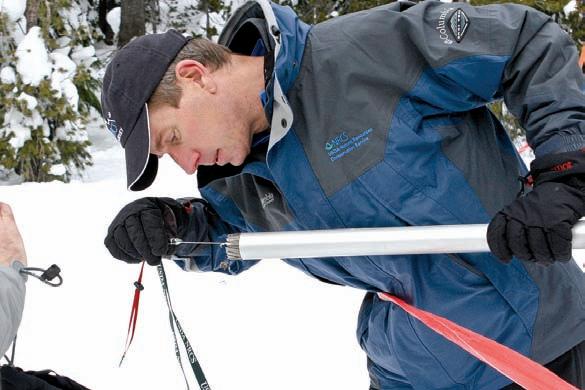
4 minute read
Green
from Jan. 14, 2016
PHOTO/KELSEY FITZGERALD
Jeff Anderson of the Natural Resources Conservation Service measures snowpack at Mt. Rose using a federal snow sampler.
Advertisement
Water watch
Winter snowpack starts strong
High on Mount Rose in early January, Natural Resources Conservation Service hydrologist Jeff Anderson stood in a snowy clearing, holding a hollow metal by pole. With both hands, he plunged the pole deep into the snowpack beneath
Kelsey his feet, capturing a cylindrical column of snow. He weighed the sample,
Fitzgerald repeating the process from four different locations at the site to ensure accuracy. The verdict? The winter is off to a good start. “Today what we measured was 54 inches of snow depth on the ground, and that snow depth contains 15.9 inches of water content. Right now, for this time of year, that’s 110 percent of normal,” Anderson said. The snowpack is the year-round water supply for this region. From January to May, Anderson makes monthly trips to this site—a SNOTEL (snow telemetry) station at Mt. Rose ski area—one of the NRCS’s network of more than 800 SNOTEL stations in the Western U.S. Though SNOTEL data collection is automated and sent out hourly via radio signal, Anderson takes on-the-ground measurements that are used to verify the accuracy of the sensors, using a method that was developed on Mt. Rose more than 100 years ago. “This is where snow surveying really began—up on Mt.
For more information on Rose,” said Anderson. The history of snow surveying in the Western U.S. has close ties to our Dr. James Church region. During the early 1900s, Dr. James Church, a professor of classics and the history at the University of Nevada, Reno, took an interest in the science of snow. of the Mt. Rose Recognizing the important connection between snowpack and the water level snow survey, visit: http://tinyurl. in Lake Tahoe, he developed a tool called the Mt. Rose sampler to measure com/zolngm9 and how much water the snow contained. Using this information, water managers http://tinyurl. could predict the amount that the lake level was likely to rise each spring. com/gu7ag4z From 1905 to 1912, Church established snowpack measurement points
For data from along snow courses at Mt. Rose and Lake Tahoe. Two of these sites have the Nevada NRCS data that go back as far as 1913, providing some of the longest running
Snow Survey program, visit: www.nrcs.usda. snowpack datasets in the country. “There are quite a few courses in the Tahoe and Truckee region [with gov/wps/portal/ data] that go back over 100 years, with measurements that he started,” nrcs/main/nv/ Anderson said. “It’s quite a data legacy. Our area is fortunate to have that.” snow/ Church’s methods spread across the West and were adopted by the For information on Federal-States Co-Operative Snow Survey in 1935, a program that evolved
SNOTEL stations into NRCS’s present-day snow survey. Today, Anderson and other snow and how they operate, visit: www.wcc.nrcs. surveyors carry on the modern rendition of Church’s work. The hollow snow tube that Anderson uses to measure snowpack—the usda.gov/snotel/ Federal snow sampler—is an updated version of Church’s original Mt. Rose
SNOTEL_bro- sampler. Though automated SNOTEL stations have largely replaced the need chure.pdf for manual snow measurements, Church’s historical snow courses are still visited and measured once per year, on April 1. At SNOTEL stations, snowpack weight is now measured using an oversized scale called a snow pillow. Since the water content in an inch of light, fluffy powder snow can vary greatly from that of an inch of wet, slushy snow, snowpack weight is considered a more accurate measurement of water content than snow depth. “Water weighs the same whether it’s a liquid or a solid. That’s really what we’re really interested in—how much water is in the snow,” Anderson said. This water, as Church realized long ago, is what will refill our lakes and reservoirs in coming months. Ω

join our team
rn&r is Hiring a distribution manager
The Reno News & Review is growing its circulation to meet the demands of increased readership and we’re looking for someone to manage our increased distribution. The Distribution Manager directs and coordinates activities of the distribution department to ensure on-time delivery of our newspaper to various locations throughout the greater Reno/Sparks and Carson City/Lake Tahoe region. Working in partnership with the Distribution Director, General Manager and other members of the management team, the Distribution Manager will establish and achieve distribution goals associated with the weekly publication of the Reno News & Review and special supplements and will supervise our outstanding team of drivers. Experience with management and distribution of publications preferred. Valid Nevada Driver’s License and clean DMV record required.
For more information on this position, visit www.newsreview.com/reno/jobs
Chico Community Publishing, dba the Reno News & Review, is an Equal Opportunity Employer.











